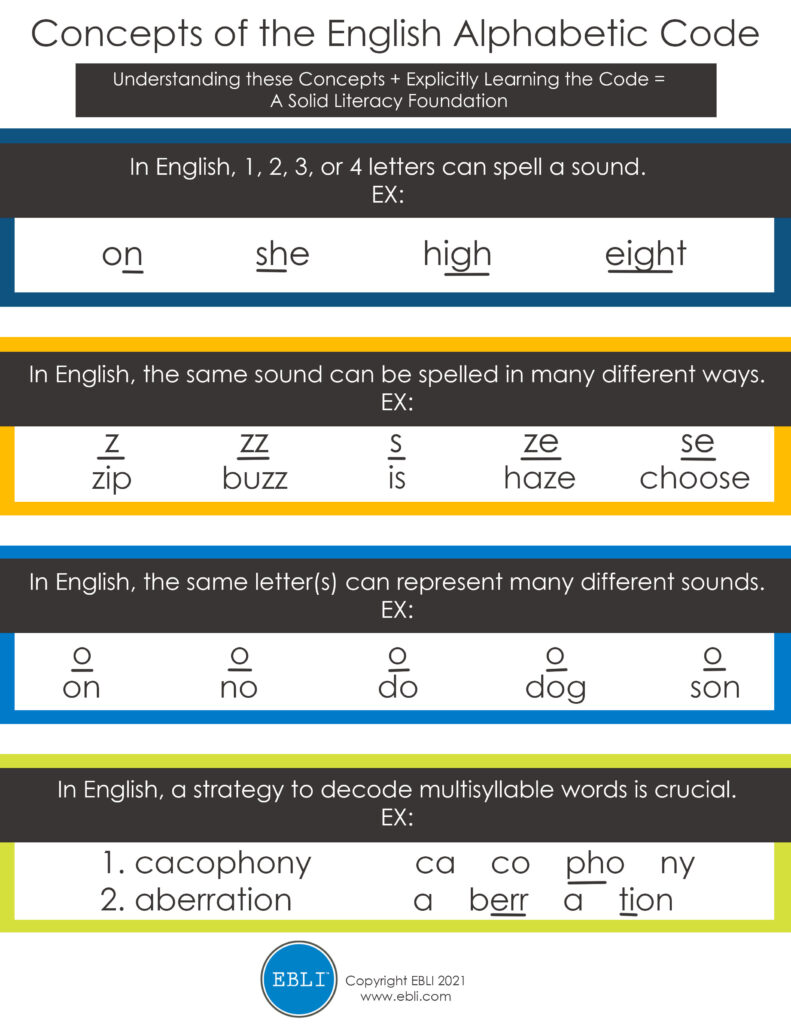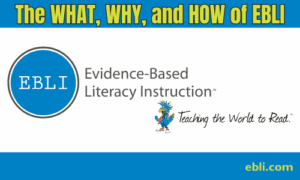This is Part 1 of a 2-part blog series. Once you’re done, be sure to check out Part 2!
Part 1: Skills and Concepts
There is a lot of debate in education circles about what reading is or isn’t, and around the term Science of Reading. This discourse can be drawn out and take up a lot of valuable time that could be better utilized elsewhere. Namely, educating and supporting teachers on how to most effectively and efficiently teach literacy and teaching children to become highly proficient readers, writers, and spellers.
FOUNDATION FOR GREAT READING – SKILLS & CONCEPTS
What is not up for debate is that the reading and spelling of words is based on the English alphabetic code, or phonics. This code is the foundation for reading and spelling. For decades, the Science of Reading – in education, cognitive psychology, linguistics, and neuro-science – has strongly supported explicit instruction in this code. As with building a house, reading and writing consist of many components. However, having a firm foundation is imperative to the success of creating both a solid house and a highly proficient, accurate reader. The complex process of reading and writing is a man-made phenomenon. It is not natural for humans. In order to become highly adept at reading and writing, the English code must be taught in order for the foundation to be firmly set in place. Once that foundation is solid, and even as it is being solidified in students, it can be built upon with all the other facets that make up reading and writing. These include, but are not limited to, background knowledge, vocabulary, phonemic awareness, handwriting, fluency, spelling, and comprehension.
The focus of this blog is instruction in the code or phonics: matching the sounds we say to the letter(s) that represent them.
Think of various codes you have learned or heard about. As I child, I loved the codes on the back of cereal boxes. For example, a triangle = ‘p’, a diamond = ‘t’, and a rectangle = ‘a’. With this code, an image of a diamond, followed by a rectangle, followed by a triangle would represent the word ‘tap’ – simple.
Conversely, the CIA and war communications use complex codes. For example, the Navajo Indians supplied code talkers to send and receive messages during WWII. This code was so complex it was one of the few codes used during the war that was never broken. The movie Navajo Code Talkers of WWII depicts this story.
The Spanish and Italian languages are made up of simple codes which are easy to learn. Italian children learn the simple code easily and quickly, in a matter of weeks. There are 21 letters, or symbols, and each represents one sound. This is similar to the cereal box code and is easy to decipher.
Conversely, the English language is made up of a complex code and is more challenging to learn. If this code is not explicitly taught, the majority of learners will not understand it or be able to apply it to effectively and efficiently read or spell. A small percentage of learners do figure the code out on their own to a degree, though rarely to their highest potential. Most are baffled by this code, as you and I would be by the Navajo code.
You may be wondering – why is the English code so complex? The core reason is that English spellings are borrowed from several other languages. Because of this, there are some concepts – along with the English alphabetic code – that need to be taught, practiced, and understood in order for someone to manage the code proficiently. The very good news is that there is a system of logic that simplifies the acquisition and application of this code! While this system of logic is rarely taught to students (or their teachers), the other good news is that this situation can be rectified by the explicit teaching and training of educators, who then explicitly teach it to their students. Because learning to read is a multi-faceted cognitive process that requires significant brain work, and because the code is complex, both learning and teaching it requires time and effort.
Following are concepts of the English code; understanding these concepts along with explicitly learning the code will accelerate the journey to accurate, automatic reading and spelling. This lays a solid foundation that leads to more easily acquiring the other components of literacy.

To keep or share the graphic above, you may save it to your device or click here for a PDF version.
The phonemic awareness skills of blending sounds together, pulling sounds apart, and moving sounds around in words are also imperative in order to optimally utilize the English alphabetic code for reading and spelling.
Teaching these concepts and skills, along with explicitly teaching the English code, will provide students with the foundation to accurately read and spell words. Accurate word reading is the foundation upon which other tasks leading to comprehension and higher level thinking are built. Accurately spelling is the foundation that provides the support that leads to great writing.
Samuel Johnson is credited for creating the first dictionary in England back in the mid-1700s. Thanks to the complexity of the English alphabetic code, it took him and a team of scholars over 8 years to complete the task. Typically, we are asking 5 and 6 year olds in our schools to figure out this code largely on their own. Early in their school career – often within the first weeks – they are expected to read books, with little to no explicit instruction in this complex code. It is a near impossible task!
Conversely, teachers are tasked to get their students reading proficiently without themselves having been given training or instruction on how to teach this complex code. All around, this is an unfair situation and is much of the reason that only 65% of 4th graders in the United States are proficient in reading.
Research shows unequivocally what we need to do to teach the foundational skills, concepts, and information to students so they are able accurately and automatically read and spell words. Teachers need to know how to effectively and efficiently teach this. Students need to be able to learn this in order to become highly literate. All of us interested in high level literacy for all are tasked to put the debating in the background and do whatever is necessary to get teachers and students what they need.
In Part 2 of this blog series, I’ll share some dos and don’ts that will help accelerate the teaching of the English alphabetic code/phonics. If you are interested in learning more, click HERE for our free webinar.
Have you seen a student confused by the complexity of the English code? If so, how were you equipped to provide support? Share in the comments.
This is Part 1 of a 2-part blog series. Once you’re done, be sure to check out Part 2!





